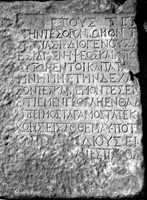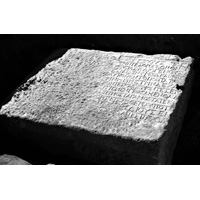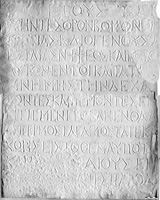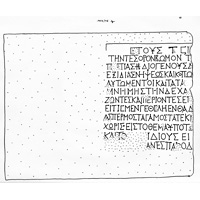 MAMA XI 63 (Dionysopolis)
MAMA XI 63 (Dionysopolis) 
Funerary epigram of Papias
- Type of monument:
- Funerary inscription in verse.
- Location:
- Bekilli (Dionysopolis): recently dug up in the vineyard of Kabak Hasan, 800m east of the village, on the south side of a valley; now (2012) in Pamukkale museum.
- Description:
- Block of coarse whitish marble, face rough-picked with a chisel, with defaced mouldings above, below and left; apparently complete.
- Dimensions:
- Ht. 1.02; W. 1.33; Th. 0.31; letters 0.035-0.047.
- Record:
- Squeeze; line drawing; MB notebook copy; photograph (1956/76).
- Publication:
- Corsten 1995: 218-21, no. 3; (SEG 45, 1756); I.Denizli 183 (E. Miranda).
- Date:
- AD 221/2 (Year 306 of Sullan era).
ἔτους τς´, μ[ηνὸς - - -]
τήν τε σορὸν βωμόν τ[ε - - -]
Π[α]πίας β´ Διογένους δ[- - -]
ἐξ ἰδίας νήψεως καὶ κόπω[ν - - -]
5αὐτῷ μέντοι καὶ Τατᾳ v. [- - -]
μνήμης τήνδε χά[ριν - - -]
ζ̣ῶντες καὶ περιόντες ἐπ̣[- - -]
εἴ τις μέν γε θέλῃ ἐνθάδ[ε - - -]
ἄσπερμός τ᾿ ἄγαμός τ᾿ ἄτεκν̣[ος - - -]
10χωρὶς ὃ εἰς τὸ θέμα ὑπὸ τῶ[ν - - -]
[. . . . c. 8 . . . . π]άντες παρ̣οδ[εῖται - - -]
Line 3: [- - -]ιας † Διογένο̣[υς] C(orsten); [- - -]σίας β΄ Διογένο[υς] M(iranda).
Line 10: χωρὶς εἰς τὸ θέμα ὑπὸ τῷ [βωμῷ?] C; [συν]χωρίσεις M.
Year 306, Month... this tomb and tombstone... Papias, son of Papias, grandson of Diogenes... through his own sobriety and labours... for himself and Tatas... in memoriam... while still living and surviving... but if anyone wants to [sc. inter another body] here... [sc. may he be] without seed, without marriage, without children... except for that which... into the tomb by the... [greetings to?] all passers-by.







The right-hand side of this inscription had been damaged by the time it was copied at the Denizli Museum at Pamukkale by Corsten 1995, and Ballance’s photograph shows several extra letters at the ends of lines 1-4. Although the face of the stone has been severely defaced by chiselling, the left-hand edge of the inscription appears to be preserved; presumably the text continued on a second block to the right.
The sequence of thought in the inscription is reasonably clear. I can find no parallels for the use of the rare term νῆψις, ‘sobriety’, ‘seriousmindedness’ in line 4; for κόποι in this context, compare IAph2007 13.702, lines 10-11, ἐξ ἰδίων ταῦτ᾿ ἐπέγραψα κόπων; SEG 43, 923 (Pompeiopolis), lines 6-7, ἐκ κόπων ἐμῶν ποιήσας κενοτάφιν; cf. also Robert, Hellenica XI/XII, 429-35 (SEG 29, 1400; I.Denizli 153: Eumeneia), A 5-12, κατεσκεύασα τὸ ἡρῷον... ἀπὸ τῶν ἐμῶν καμάτων. For the female name Τατας (line 5) in this region, cf. SEG 45, 1737 (sanctuary of Apollo Lairbenos; the wife of a villager from Motella).
For the curse-formula in line 9, see Strubbe 1997: no. 292bis (suggesting that the monument might derive from Laodikeia). In line 10, the antecedent of the relative pronoun ὅ is presumably a phrase like (ἕτερον) πτῶμα in line 8. If line 8 is intended to be a pentameter, we could restore e.g. εἴ τις μέν γε θέλῃ ἐνθάδ[ε πτῶμ᾿ ἐπιθάψαι]; in line 10, I assume that the sense is something like χωρὶς ὃ εἰς τὸ θέμα ὑπὸ τῶ[ν δηλουμένων τεθήσεται] ‘except for that (body) which [is placed] in the tomb by the [aforementioned]’, vel sim.